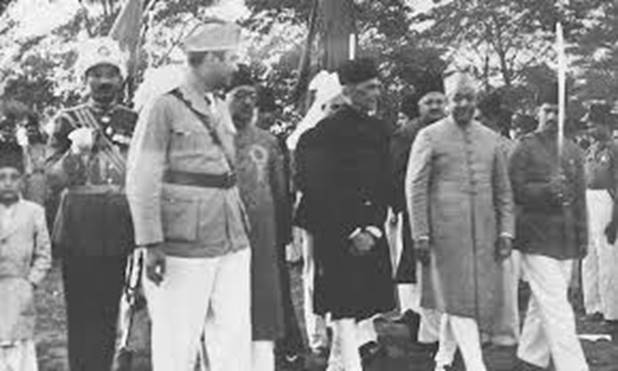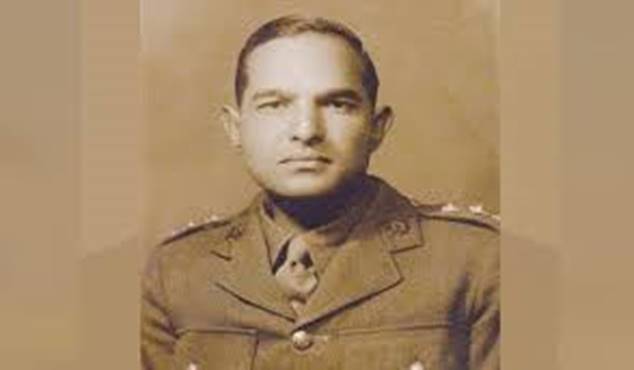
On 22 March 1940, Quaid-i-Azam was driven in regal style in an open buggy to Minto Park. My nephew, Syed Khalid Hussain, filmed the journey with his movie camera. Had it not been for him, this historic event would not have been preserved in live images. We donated the film [Shahji is clearly visible in that historic film] to the Pakistan government. Every year, on March 23, it is shown on television. The public meeting was attended by thousands of people
The Last of the Mohicans Gone: Remembering
Colonel Amjad Sayed
By Prof. Dr Ishtiaq Ahmed
Sweden
With the departure of Colonel Amjad Hussain Sayed on 19 June 2017 in Lahore, the curtain finally comes down on those who were witness to the rise of Mohammad Ali Jinnah as the charismatic leader of Indian Muslims and the All-India Muslim League as the party demanding the creation of Pakistan.
Born in Gujranwala, Shahji grew up in Muslim Town, a Muslim locality his uncle, Dr Syed Mohammad Hussain, had helped establish. He passed the matriculation exam from Muslim High School and then was admitted to Islamia College, Railway Road, Lahore. In 1940, he passed the MA examination in Economics and subsequently joined the Army. After the creation of Pakistan, he was sent on overseas assignments, most notably as Military Attaché to the Pakistan Mission to Indonesia.
Since I have a fascination for the freedom movement and especially how it could not remain united against the British, but split into a Congress-led movement demanding a united India and a separatist movement led by the All-India Muslim League demanding a separate Pakistan, meeting Colonel Amjad Hussain Sayed was crucial for me to understand how and why suddenly the demand for Pakistan caught the fancy of Muslims: he was a witness/participant to the crucial period in the chain of events culminating in the creation of Pakistan. I met Shahji on 2 February 2014 at his Lahore residence in New Muslim Town.
I learnt that, as young students, he and Hameed Nizami used to visit Allama Iqbal, who told them that Mr Jinnah was the Man of Destiny who would lead the Muslims onwards to successful statehood. Both met Mr Jinnah when he visited Lahore in 1936. They were simply bowled over by the handsome barrister dressed up meticulously in High Street Western clothes, who spoke flawless English, but about whom Iqbal had predicted would provide the leadership to counter Gandhi and Nehru. They told him that Iqbal had said to them, “‘Follow Jinnah Sahib in whatever he does,” and they were ready to follow him.
That meeting was short, but just as the two young lads were spellbound by the personality of Jinnah, he too found their enthusiasm irresistible. To their very great surprise, both were despatched by Allama Iqbal to attend the 1937 Lucknow Session of the Muslim League, which was held immediately after the disastrous defeat it suffered in the provincial elections.
Shahji narrated an incident from that session, which is worth mentioning here. He told me:
While the deliberations were going on, Maulana Zafar Ali Khan interrupted us and said a pause was needed so that he and others could offer the Isha prayers. Jinnah said, “Look, Maulana, we are discussing the freedom of the Mussalmans. You can go out and perform them but we shall continue our meeting.” During that historic session, on one public occasion, Mian Ferozdin Kaada from Lahore’s walled city raised the slogan, ‘Shehanshah-e-Hindustan Quaid-i-Azam Mohammad Ali Jinnah.’ Jinnah responded, ‘I am not shehanshah of Hindustan; I am only a servant of the Mussalmans of India.’ The title Quaid-i-Azam, however, came to be associated with him thereafter. Its inventor was Mian Ferozdin Kaada of Lahore.”
The most important event to which Colonel Sahib was witness was, of course, the 1940 Lahore session of the Muslim League. He recalled:
On 22 March 1940, Quaid-i-Azam was driven in regal style in an open buggy to Minto Park. My nephew, Syed

“Both Iqbal and Mr Jinnah wanted to create a welfare state in which there would be no place for obscurantism. Their vision of Pakistan was inclusive and did not exclude non-Muslims. That vision subsided with the death of Quaid-i-Azam. Pelf took over and now we are in a sorry state of affairs.” – Colonel Amjad Hussain Sayed
Khalid Hussain, filmed the journey with his movie camera. Had it not been for him, this historic event would not have been preserved in live images. We donated the film [Shahji is clearly visible in that historic film] to the Pakistan government. Every year, on March 23, it is shown on television. The public meeting was attended by thousands of people.
I remember Mian Bashir Ahmed recited a poem welcoming the Quaid to Lahore. Thereafter, other speakers spoke. On March 23, Sher-e-Bengal A. K. Fazlul Haq moved the Lahore Resolution, in which the demand for the creation of Pakistan was made. It was truly a manifestation of Muslim power and Mr Jinnah was at his very best when he spoke. I asked our servant, Sharifa, who was also there if he understood what the Quaid had said. He replied that whatever he is saying is the truth.
He continued:
During World War II, I was posted in the Middle East but, in 1946, I returned and was posted in Bareilly. I was an Army captain at that time. One day, while riding my bicycle, I saw a Hindu classmate of mine from Lahore, coming in a jeep from the other direction. When he saw me, he called out my name and we met with great warmth. He told me that, in the evening, some officers were going to meet and that I should come along with him.
So, I went to the party that evening. It was a gathering of mostly English officers but some locals were present as well. Lieutenant Colonel Azam Khan (later General Azam Khan) was the chief guest. He made a remark that greatly agitated me. He said, “Mr Jinnah is a madman. He wants to divide India and divide this beautiful Indian army. How is that possible?” I retorted, “Sir, you have no right to speak like this about Mr Jinnah who is a great leader of the Muslims. We have great respect for him. I have great respect for Mahatma Gandhi, too, but Mr Jinnah is our leader. He will get Pakistan and you, too, would benefit from it.” When I said this, the officers present started clapping.
I then asked Shahji about Iqbal’s and Jinnah’s vision of Pakistan. He replied, “Both Iqbal and Mr Jinnah wanted to create a welfare state in which there would be no place for obscurantism. Their vision of Pakistan was inclusive and did not exclude non-Muslims. That vision subsided with the death of Quaid-i-Azam. Pelf took over and now we are in a sorry state of affairs.”
I went on to ask him how relations between Muslims and Hindus were in pre-partition days, to which he answered, “There was relatively less prejudice. Of course, at the railway stations, two different stalls offering ‘Muslim pani’ (Muslim water) and ‘Hindu pani’ (Hindu water) underscored the wall between the two communities, but among more enlightened people, such prejudices were less so. As I told you, when my Hindu class-fellow from Lahore and I met in Bareilly, we were overjoyed by that chance meeting and embraced each other.”
As my final question, I asked him what his opinion was about Gandhi: “Gandhi was a great leader, a dervish-khaslat human being.”
Colonel Amjad Hussain Sayed is now no more. My meeting with him will always remain etched on the eye of my mind. His mind was sharp, his enthusiasm for Iqbal, Jinnah, and Pakistan was steadfast, yet he expressed no hostility toward Mahatma Gandhi. He also did not subscribe to the theory that Hindus and Muslims were necessarily estranged beyond repair. I could sense that he was disappointed with the way Pakistan had evolved after the demise of Mr Jinnah, but his optimism remained.
The breed of men like Shahji is all but gone, and now we live in the era of Lilliputians.
(Professor Ishtiaq Ahmed is Pakistan’s leading historian and is Professor Emeritus of Political Science, Stockholm University, and author of the award-winning book, “The Punjab Bloodied, Partitioned and Cleansed”, Oxford University Press 2012).

